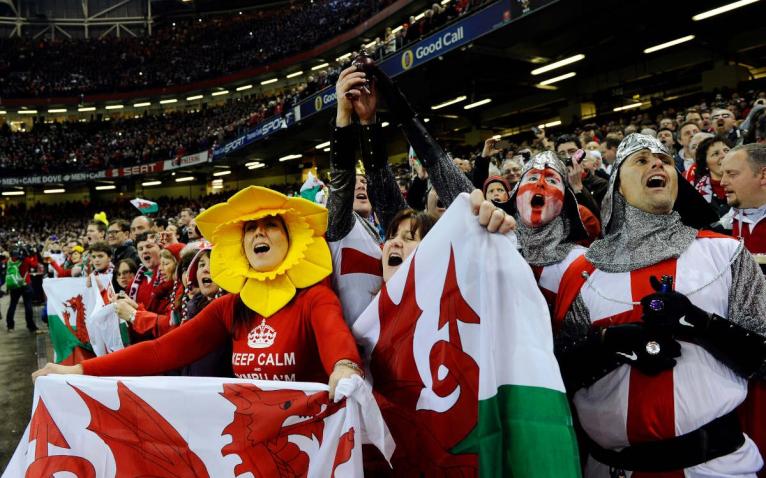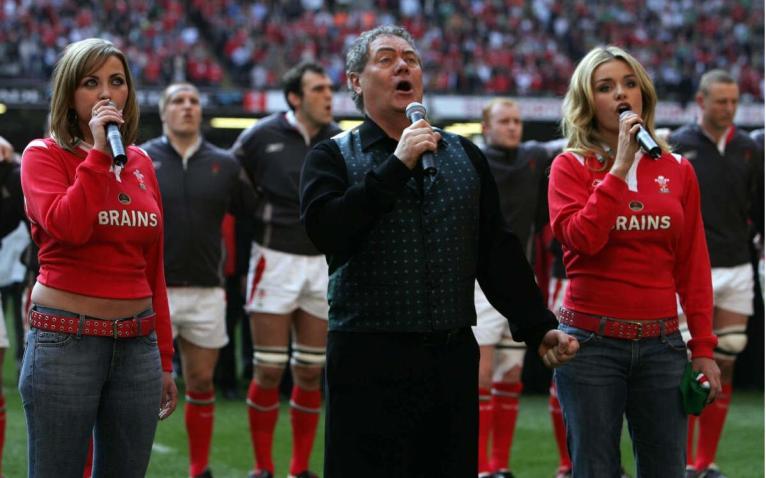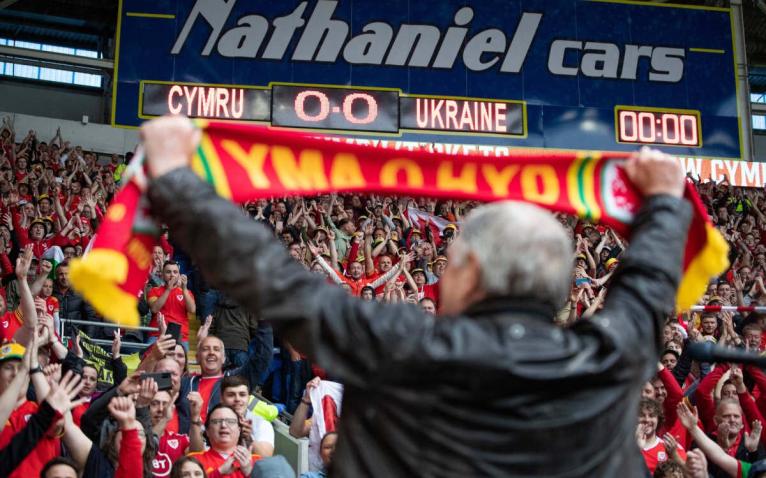“The crowd at Cardiff are more important than perhaps to any other ground in any other country because it’s so intimate. Twickenham and Murrayfield are so far from the play but Cardiff is like theatre in the round.”
Max Boyce
It’s been almost ten years since Wales beat England 30-3 to win the 2013 Six Nations title – and deny England a Grand Slam – in a match that has arguably done more to define the modern image of Welsh rugby than any other over the last decade.
It was the match which irrevocably underlined the merits of ‘Warrenball’. The backline that day included Phillips, North, Roberts, Davies and Cuthbert; megatrons at speed. As red jerseys rubbed white ones into the mud, any notion that Wales under caretaker coach Rob Howley would move away from an all-power game disappeared. Welsh teams since have either tried to emulate that performance, or – under Wayne Pivac – attempted to move away from it in search of something else. Something more noble. Something more, well, Welsh.
But the reason this day a decade ago is so lodged in Welsh rugby consciousness is not only for what happened on the pitch, but because of what happened around the pitch, around the stadium, and around the city. Ask Welsh fans for their memories of that day – Saturday March 16 2013 – and their fondest smiles are reserved for talking about the atmosphere.
The official count was 74,104 people in the stadium. And each Welsh voice made theirs count like never before.
The WRU chose this day to cut the band during the chorus of the national anthem for the very first time, to unleash the power of song, and song alone. They played a blinder on that one.
Going by the metric for all modern day culture: YouTube views; Welsh fans are more likely to re-watch the national anthem that day than highlights of the match. The most watched replay of the anthem has been viewed 4.9 million times – ten times more than any highlights package.
It’s easy to see why.
Every Welsh player’s face offers a different window into a surging furnace beneath. Appropriately Ken Owens is first in shot, chest puffed out, loudly leading the opening line. By the second line, Paul James is shaking, twitching and blinking all at once. Leigh Halfpenny has eyes so puffy they look like giant black orbs. He is a man possessed. Jamie Roberts’ nostrils flare, and maybe a lip wobbles. There’s even a bead in the eye of Adam Jones. Biggar and Warburton seem almost unaffected. Truly remarkable.
Yet what gets you pulling the cursor back to the beginning and re-watching again and again is the sound. It’s truly beautiful. Hen Wlad Fy Nhadau is always special but that day it entered a new realm. It was one giant, expert choir, dressed as daffodils, with glittery trilby’s and red wigs.
The WRU’s Musical Director, Haydn James, was at the centre of that astonishing choral coming together, standing just behind the players in front of the choir.
“I’ve done a 130 games for Wales and I have not had goose bumps all that often,” James told RugbyPass+.
“But that day, that day was magic. Absolute magic. You suddenly felt, ‘there’s no way we’re going to lose today’. If the team feel what I am feeling, that they had, however many thousands behind them, really behind them, then there will be no stopping us”
In the 1950s and 1960s, the singing at rugby internationals in Cardiff was spontaneous. It was mainly hymns and the occasional Welsh folk song like Sosban Fach.
Haydn James, WRU musical director
James could lay claim to having done more in the service of singing at Wales rugby matches than anyone else alive. With the exception of the very first match in 1999, a trial match with 20,000 spectators, Haydn has conducted choirs at every single Wales international at the Principality, without exception.
Having conducted the nation’s rugby voice for so many years, James could not be better placed to assess its vitality a decade on from that day in 2013. And like any health check, it’s a process best served by taking a history first.
“In the 1950s and 1960s, the singing at rugby internationals in Cardiff was spontaneous,” James tells us. “It was mainly hymns and the occasional Welsh folk song like Sosban Fach. There were various hymns that everybody knew, Cwm Rhondda, Calon Lan, Love Divine all loves excelling. It stemmed from the chapels because we all learned our hymns in chapel and at school assembly. We used to do a hymn every day of the week at Maestaeg Grammar School, all the way through to 18.”
The fact that James’ schooldays were filled with song was thanks to a religious movement that had taken hold in Wales more than 100 years before, which moved away from the high church pretensions of the Church of England, to more practical, more enjoyable forms of worship. That meant singing hymns, often Welsh language hymns.
The movement was known as nonconformism and it’s golden era came between 1810 and 1905. Over this period, chapels were built in Wales in ever more earnest numbers, as communities clamoured for space to sing as one. It’s been estimated that at the peak of Welsh chapel-going, the combined seating capacity of all the chapels in Wales exceeded the country’s population size.

And the chapels worked hard for their communities. Any given chapel would offer up to three services on a Sunday, along with a jam-packed weekly calendar of social and religious gatherings where singing would play an integral part.
The chapel movement of this era went hand-in-hand with what Max Boyce (more of him later) would describe as the time of ‘the collier and the candle’ as Wales became an industrialised mining powerhouse. Mining powered the economy, and the chapel nurtured society. Song being one of the key features of life in both the pit and the pulpit.
There is simply nothing else like Cardiff in the rugby world. It’s the singing that does it. And it’s the chapel movement of the 18th century that we can thank for that.
In this way, singing became an indelible strand of Welsh identity, buried so deep it survived a century of subsequent decline in chapel attendance (from 1905 onwards) to burn bright up to the present day as a way of expressing national identity. Not as bright as once it did. But bright enough to blow the socks of anyone who attends a Six Nations matchday at the Principality Stadium.
There is simply nothing else like Cardiff in the rugby world. It’s the singing that does it. And it’s the chapel movement of the 18th century that we can thank for that.
But let’s go back to the future. By the 1970s, James believes that the decline in chapels had diminished the spontaneous singing at internationals in Cardiff.
“For decades people hadn’t been going to chapel in such great numbers,” he said. “So they weren’t learning the hymns as well.”
But hymns were still being sung at rugby matches, with plenty of passion, even if not everyone knew all the right words.
It’s a theme Max Boyce picked up on too in his 1970s ballad 10,000 Instant Christians, when he sings of hymns sung at an international in Cardiff being “only half remembered”, and recalls that Cwm Rhondda and Delilah were “sounding both the same” – a theme he repeats in the fabled Hymns and Arias, but in 10,000 Instant Christians it’s a lament, rather than a point of humour.
It’s undoubtedly one of Max’s most poignant songs – topped in that regard only by his ballads of life in the mining communities of south Wales: Rhondda Grey, Duw it’s Hard and Did You Understand?
Yet whilst Boyce lamented the decline in hymn singing at rugby matches, he was simultaneously launching a revival of it. For his brand of folk singing merged a reverence for Welsh hymns with a celebration of 70s rugby culture, which itself was experiencing a golden age. Boyce fed the Welsh rugby public a new diet of music and lyrics, whilst the national team gave them every reason to sing long and loud for an entire decade.
As a result Boyce’s classic Hymns and Arias – about a trip to Twickenham to see Wales defeat England – was taken to heart by the Welsh rugby public and sung for the first time in Arms Park in 1972.
Boyce spoke to Rugbypass+ exclusively about that day.
“I had been summoned to sing on Grandstand before the England-Wales game in Cardiff,” Max said. “And because I was going to be interviewed by Frank Bough and because it was a big occasion, I bought an expensive David Parry-Jones coat which was very en vogue at the time. It was a sort of suedette, with a fur collar. At the time, all sports presenters wore them, they were the ‘in’ thing. I bought it, couldn’t afford it, but I bought it because I was on Grandstand.
“Whilst I was being interviewed by Frank on the touchline, some people in the crowd recognised me and started singing Hymns and Arias and it spread to the whole ground, for the first time ever.
“I was obviously excited about the song being sung and I rang home and asked my mother ‘did you see Grandstand mam?’ She said ‘oh yes, your coat looked lovely’!”
Boyce would be the toast of Cardiff on many occasions to come, and still is. Yet surprisingly for a man so loved in Wales, his last performance at the Principality Stadium was in 2005, ahead of the Grand Slam game against Ireland.

Boyce remembers that “the whole ground was singing Hymns and Arias towards the end of the match. It’s not often you know you’ve won but we were so far ahead. Someone in the paper the next day wrote that there were ‘continuous, delicious renderings of Hymns and Arias’. To hear that when you are there. And to win the Grand Slam, it doesn’t happen very often.”
Boyce had of course also sung the roof off Wembley six years previously when Wales were playing their Five Nations home games at the home of English football.
On that occasion in 1999 there was no Grand Slam on the line for Wales, yet there was for England, and Boyce, Tom Jones and James were all present to serenade the Wembley crowd and whip up a Welsh fervour before kick-off. It famously worked, as Wales beat England 32-31 thanks to a Scott Gibbs try and a dead-eyed Neil Jenkins conversion.
That day was Max’s all-time favourite Wales-England occasion – but just getting him to Wembley was a story in itself.
Boyce was due to be playing golf with Ian Woosnam no less, until James asked if he would come to Wembley and sing in front of 90,000 people instead, adding that if he could write a new verse to Hymns and Arias to capture the day, then so much the better.
England came down the tunnel to a wall of Welsh singing from the stands. Wales entered, led by Shenkin the Goat, with Scott Gibbs smiling ear-to-ear already. He knew something. England didn’t stand a chance.
Boyce swiftly cancelled his golf and wrote a rousing new verse about Wales returning to a new home in Cardiff “with a sliding roof / that they can move away / they’ll slide it back when Wales attack / so God can watch us play.”
Tom Jones followed up with a typically bombastic rendition of Delilah and both men stayed on the field to sing Cwm Rhondda alongside the London Male Voice Choir, Jones having even come to a rehearsal with Haydn earlier in the week to get ready.
With Wembley at a fever pitch, England came down the tunnel to a wall of Welsh singing from the stands. Calon Lan this time being sung. Wales entered, led by Shenkin the Goat, with Scott Gibbs smiling ear-to-ear already. He knew something. England didn’t stand a chance.
Wembley 1999. Cardiff 2005 and Cardiff 2013. Three occasions where a magnificent Welsh performance from the stands has preceded a magnificent performance on the field. There have been many others, but those three stand out especially in the professional era.
A performance of a similar ilk from the stands on Saturday might go a long way to inspiring Wales to victory again in the Gatland era 2.0.
But what are the chances? Is the Principality’s voice in rude enough health in 2023?
“It’s still the best in the world,” says actor and rugby broadcaster Rhys ap William, who has been the Principality Stadium’s matchday announcer since 2005.
“It’s not just me stating that either, that’s what other people say, the visiting fans. It’s Welsh people who are most likely to complain!
“Cwm Rhondda or Bread of Heaven, Calon Lan, Sosban Fach, Hymns and Arias, and Delilah are all sung without any nudging from us.
“We promote singing at the stadium of course but you can’t manufacture atmosphere. It comes from outside. The only thing that creates atmosphere at the Principality, is a bloody good game of rugby.
I get a bit upset when people say Yma o Hyd is a football song, because that’s simply not the case. Dafydd Iwan wrote that song, and gifted it to Ray Gravell when he was President of Llanelli.
Rhys Ap William, commentator
“Singing and atmosphere are so entwined with a good game because they merge into each other. If there’s a tackle, a break, then there’s the noise. If the game is flat I don’t care if you’ve got Bryn Terfel, or a stadium of Bryn Terfel’s.”
Ap William does concede that he has noticed a dwindling in singing at Wales internationals over time.
“I am from the generation that know the words to almost every rugby song out there but I have seen a change over the last 17 years,” he said. “I was a chapel goer, but people aren’t going to chapel and church as much as they used to.
“It’s how the world has changed, not just how Welsh rugby has changed. I doubt even whether many people know that Hymns and Arias is a song about a trip to Twickenham. They know some of the words and the chorus of course, but do they know what it’s about?
“Maybe we need that trigger, a new boost. There hasn’t been a belter sung about rugby for a long time. I get a bit upset when people say Yma o Hyd is a football song, because that’s simply not the case.
“Dafydd Iwan wrote that song, and gifted it to Ray Gravell when he was President of Llanelli and it’s been a Scarlets anthem for the past 20-plus years. It’s a great song. I’ve heard it sung organically at Parc y Scarlets. And at the Principality. But it hasn’t caught on in rugby like it has in football, and fair play to the FAW (Football Association of Wales) they’ve been very good at realising the popularity of Y Gymraeg (the Welsh language) and embracing it. That’s the kind of thing we need a bit more of.

“I’d love it if 80% of people coming to the stadium knew two songs fully, I would love that. But you can’t tell people ‘here’s your ticket, here’s your song sheet, learn them or you can’t come’.
“In the autumn, the choral outlay was phenomenal. Young choirs were involved, schools across Wales too. But we need every fan to realise that every voice counts and that the Principality can be a chapel of 70,000 instant singers.”
Wales’s formal choral tradition is proudly upheld by well over a hundred choirs from across Wales, and James and the WRU bring as many as they can to the Principality Stadium. The current waiting list is an impressive 50 choirs long. A long time has passed since the boom years of chapel going in 19th-century nonconformist Wales but the popularity of choirs is quietly resilient.
The biggest and best choir in Wales, however, is the 74,000 touchline tenors that will come together this Saturday afternoon for Wales-England.
What voice it is in encompasses many factors. Factors that are out of any one person’s control but which every person has a say in. Yes, a performance from the stands will feed a performance on the pitch, yet it will also out-live the performance on the pitch.
As Max Boyce told us: “It’s not so much about the game, it’s about the passion that attends the game.”


Interesting that it was the London Welsh Male voice choir that sang in both 1999 and 2013. I was in that choir for the 2013 game and have never known anything like it. Sadly we won’t be the choir on the field on Saturday, but I’m sure the choir that is and the crowd will do their level best to raise the Welsh team to a performance against the old enemy.
Thanks for this, inspirational and informative!! Love it!